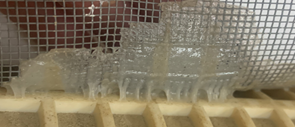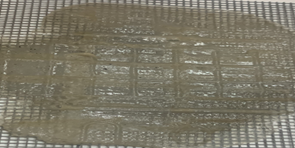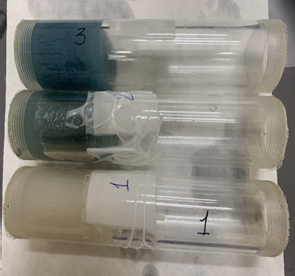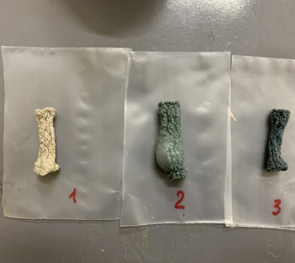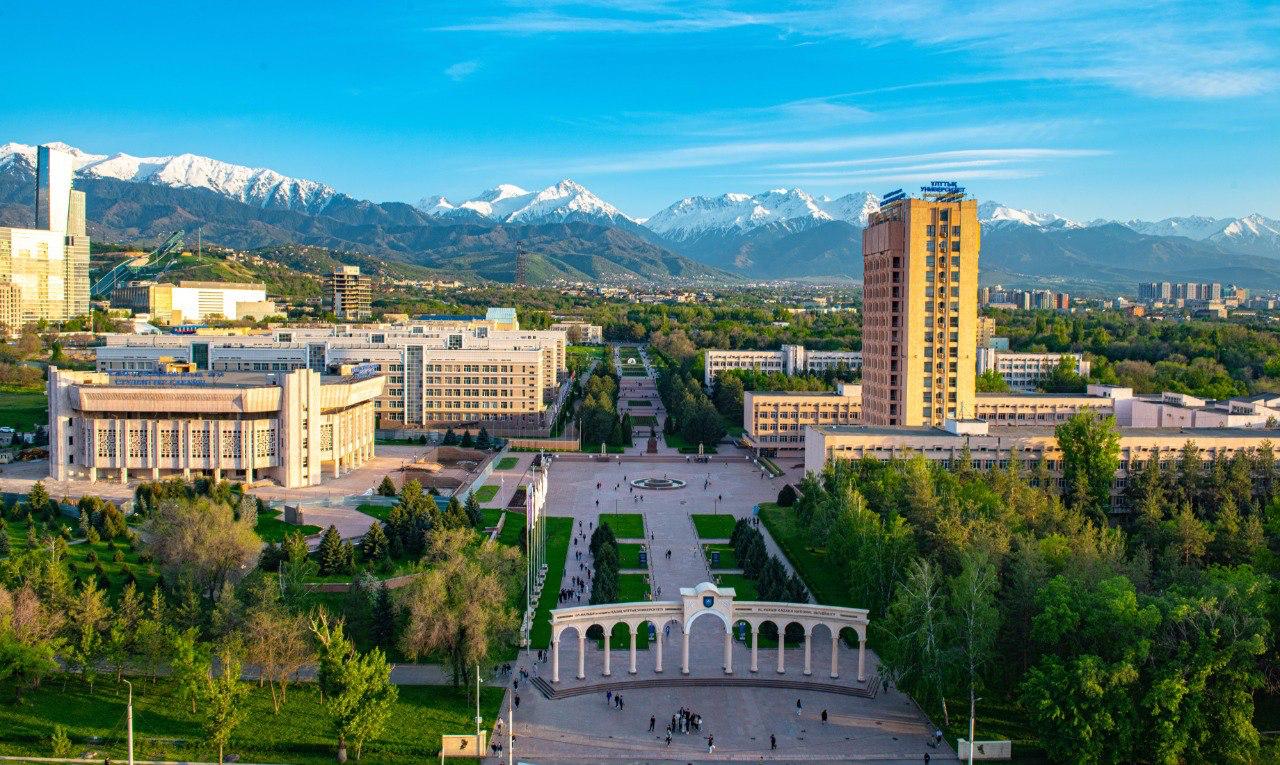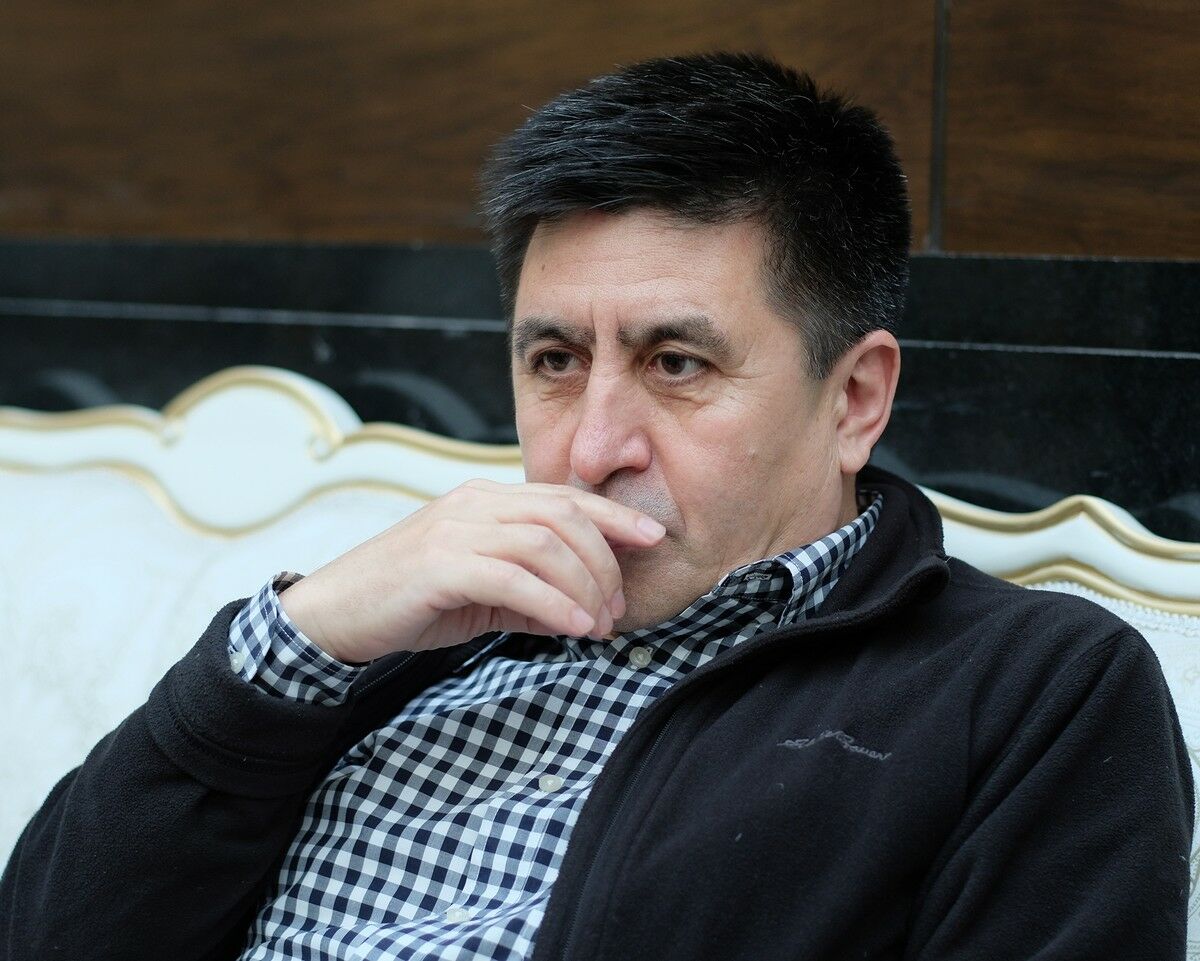- Main
- Articles of teaching staff
- HYBRID COMPOSITE MATRICES TO PREVENT RADIONUCLIDES FROM SPREADING INTO THE ENVIRONMENT
HYBRID COMPOSITE MATRICES TO PREVENT RADIONUCLIDES FROM SPREADING INTO THE ENVIRONMENT
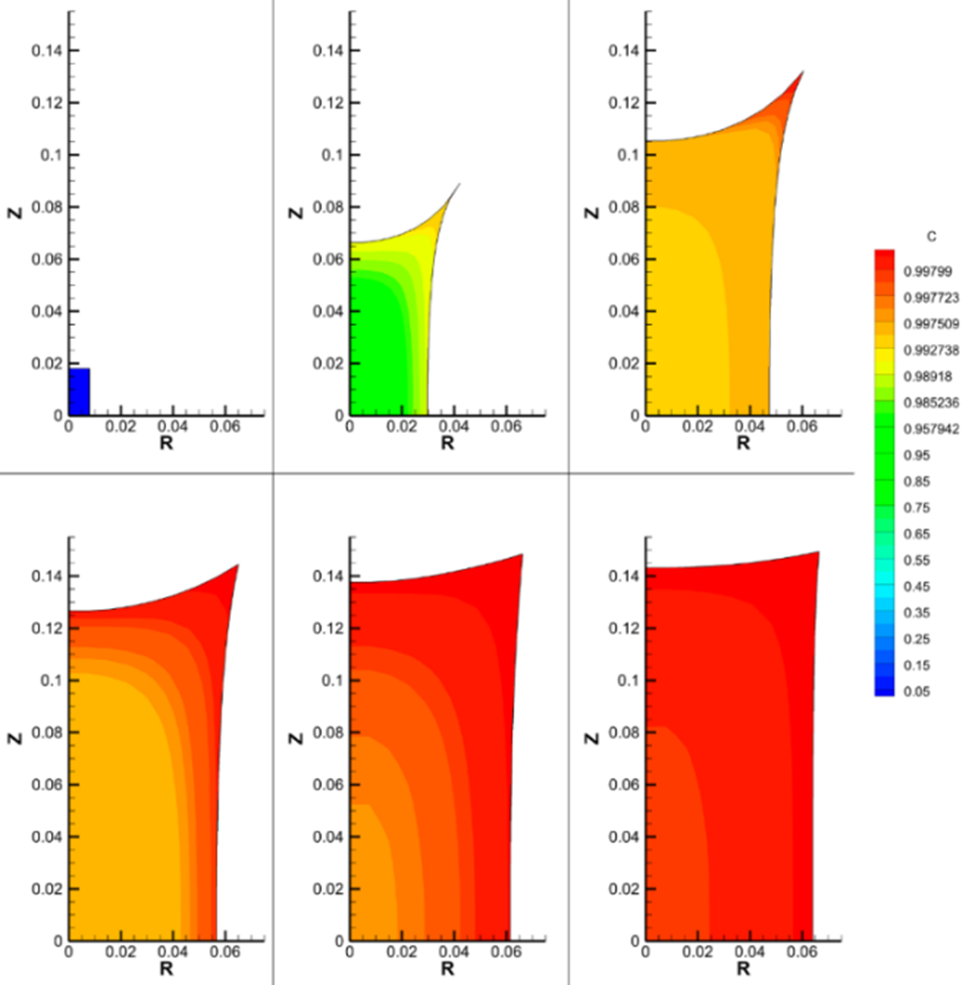
Hybrid composite matrices to prevent radionuclides from spreading into the environment
G.K. Mamytbekov*1, N.M. Shayakhmetov, M.B. Kurmanseiit, N. B. Issabayev
1Institute of Nuclear Physics, Almaty 050032, Kazakhstan;
2Department of Mechanical Engineering, Satbayev University, Almaty 050013, Kazakhstan
3Senior student of Quantum STEM School, Astana
Correspondence: mamytbekov@mail.ru
Abstract: The successful development of hybrid composite materials (HCM) with high sorption capabilities for radionuclides in liquid radioactive waste has been considered. The hybrid composite materials consist of two sorbents, which originated from an organic and a natural minera containing intercalated ferrocyanide complexes of transition metal ions. A high level of radionuclide absorption is observed on the first stage of sorption, which is attributed to the abundant active centers on hybrid composition surfaces. Conversely, the second stage of sorption exhibits reduced and slower radionuclide absorption, possibly due to the gradual filling of the remaining active sites in the HCM. Thus, the fast sorption can be attributed to adsorption occurring on the outer surface of materials, which contrasts with the prolonged adsorption process found in the macropores within composite materials.
A comprehensive hydrodynamic-geochemical mathematical model was formulated for describing the fixation and concentration processes elucidating the migration of radionuclides via manmade geochemical barriers of liquid radioactive wastes.
Key words: hybrid composite materials, sorbents, migration, radionuclide, liquid radioactive waste, mathematical modelling, swelling.
Introduction
Technological advancements in operational practices within the nuclear industry aim to enhance environmental safety by improving waste management systems, such as recycling radioactive waste. Enhancing facilities for environmental protection, encompassing sewage treatment, air emissions control, and radioactive waste storage in various forms, generally necessitates substantial cash, energy, and material resources. The purpose is to mitigate the environmental impact of human activities in economically beneficial ways, especially for enterprises in the nuclear power sector [1, 2].
The design and construction of engineering and geochemical barriers (EGB) must take into account their operational conditions. This applies to all aspects related to the assembly of IGBB devices, from material selection, composition, and design to manufacturing and operational processes. The choice of materials is crucial for the advancement of nuclear energy and the implementation of preventive measures to mitigate the adverse impacts of NPP activities. This choice directly relies on the physico-chemical, physico-technical, and nuclear properties of radioactive waste. It is essential to consider various engineering parameters, such as electrical, magnetic, sorption, and physical-chemical properties of materials, to ensure the proper and durable operation of EGB [3, 4].
In today's operation of nuclear power plants, creating migration geochemical barriers and improving them technologically have become top priorities. This is because the benefits of low-cost electricity and high energy in various fields of science are accompanied by the adverse effects of technology and medicine, which result in the production of large quantities of radioactive waste in different physical and chemical states that are challenging to control [5,6].
Choosing the right matrix to immobilize active wastes and the right technology to cure them are both very important parts of the chain of insulation for liquid radioactive waste (LRW). Development of matrices for curing LRW has been ongoing in many countries in the world and international scientific centers for about fifty years. Proposals have suggested a wide variety of matrices, such as glass, ceramics, glass-ceramic materials, crystalline substances, and mineral-like materials that mimic natural minerals, among others [7, 8].
Investigating the targeted synthesis of novel high-performance sorbents for the fixation and concentration of leguminous radionuclide forms is highly pertinent, as it enables the alteration of the composition of the produced samples and facilitates "software" modulation of their structure and texture, thereby guaranteeing the desired functional properties and sorption capacity attributes. The research has been conducted in several domains, with the primary focus on their application as geochemical barriers in engineering structures at storage and disposal sites for low and medium-level radioactive liquid waste. The objectives were as follows:
- Methodological justification for the principles and techniques of directed synthesis of hybrid compositions incorporating various fillers through the intensification of chemical, physical, and radiation processes at the interface of mineral phases, specifically PVC ferrocyanide and polymer solutions (or monomers), with or without the presence of cross-linking agents;
- Examination of the origin of phase and structural transformations in the mineral sorbent matrix upon the incorporation of transition metal ferrocyanide microparticles during various stages of in situ polymerization and their impact on the filtration-capacitance properties of hybrid composite materials;
- Creation of a model for the hierarchical structure of hybrid composite materials synthesized using in-situ polymerization utilizing thermal or radiation initiation for polymer matrix bonding processes.
The selection of geochemical membrane constituents was based on multiple factors. Initially, all hydrogel materials serving as the primary matrix for the fixation of active radionuclide centers consist of carboxylic, carbonyl, and amide groups capable of forming electrostatic (Sr90, Cs137) and ion-coordinating (U, Np, rare earth metals (REM)) bonds with metal ions or their oxygen complexes in both acidic and alkaline environments. The compositions vary in structural arrangement, texture, and composition, enabling the creation of multi-layered geochemical membranes, each capable of selectively capturing a certain type of radioactivity within its volume. So, the hybrid composite materials are applicable for the sorption of alkaline and alkaline earth metal ions and heavy transuranium and light radionuclides.
To solve the problems presented, a mathematical model of swelling of hybrid composite hydrogels in water and diffuse migration of radionuclides with cylindrical coordinate system was developed.
A mathematical model was constructed to address the issues of swelling in composite hydrogels in water and the diffuse movement of radionuclides, utilizing a cylindrical coordinate system.
A mathematical model was developed to address the issues of swelling in composite hydrogels in water and the diffuse migration of radionuclides, utilizing a cylindrical coordinate system.
Results and discussion
Mathematical model of swelling of hybrid composite matrices and diffuse migration of radionuclides
Mathematical modeling of the swelling behavior of hybrid composite matrices and the diffuse migration of radionuclides within a cylindrical coordinate system.
The primary approach selected for this work is grounded on the law of diffusion [9], which facilitates a detailed description of the diffusion process using minimal input data [10, 11].
The change in water concentration in the area under consideration is described by the following differential equation in private derivatives:
The variation in water concentration within the specified area is represented by the following differential equation in partial derivatives:
|
∂Cw∂t=D∆Cw |
(1) |
|
|
|
где Cw - mass fraction of water in the medium.
- mass fraction of water in the medium.
D – water diffusion coefficient.
The expansion of the calculated environment is assumed to occur isotropically. The equation must consider the mathematical representation of the diffusion coefficient and the variation in sample volume during swelling. In addition, due to the nature of diffusion and water penetration, the boundary between the sample and the water into which it is immersed, the swelling front, moves. Therefore, the field of solution of the diffusion equation changes in time and a moving boundary condition must be included. Since there is no analytical solution to this problem, the authors applied computational hydrodynamics methods.
The modeling of swellings due to diffuse migration indicates that under the specified conditions, the sample experiences a 400-fold increase in size (Fig. 1), aligning with experimental data on the swelling kinetics of hybrid compositions [12]. The swelling rate correlates directly with the water volume in the sample. The duration required to attain maximum saturation depends on the sample's size and shape, in addition to the diffusion coefficient (D). The diffusion factor is determined based on experimental data.
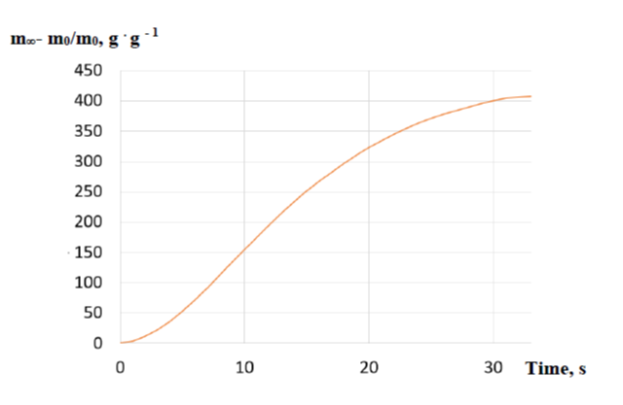
Figure 2 - Change in mass of the sample of HCM over time due to swelling
Figures 2 and 3 illustrate that the variation in sample volume is nonlinear. The increase in water migration time due to a change in volume results from the expansion of the housing matrix and, in simulations, the computational grid. The dynamics of expansion are contingent upon the existing sample size.
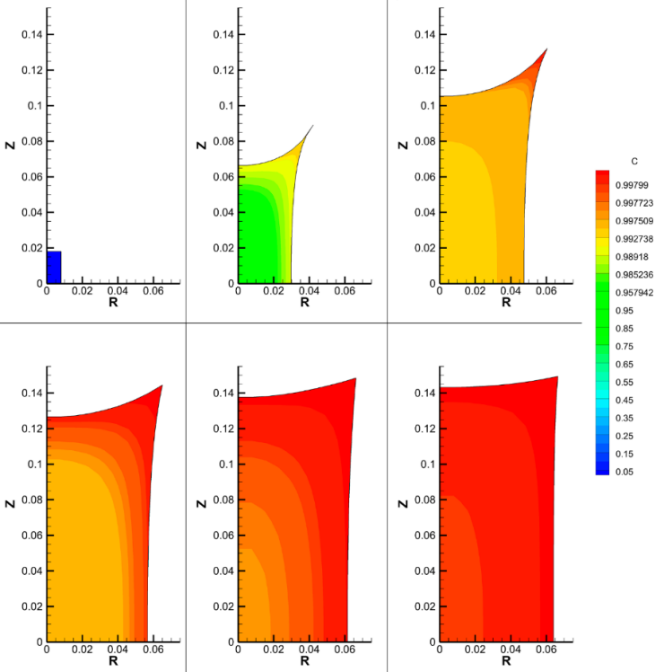
Figure 3 - Deformation of the area and change in the concentration of water in the sample over time as a result of swelling
The top right corner (Fig. 3) is extended due to heightened concentration in this region resulting from an enlarged contact surface with water. Nonetheless, upon substantial water saturation of the sample, a partial restoration of the original shape occurs, as evidenced by the accompanying images.
The release of water occurs because of a chemical reaction between radionuclides and the polymer-mineral components of HCM. Using the swellings model and the law of active masses, we can describe the general scheme of the process as a system of differential equations in private derivatives, accounting for the kinetics of chemical processes during water release and radionuclide fixation:
- for components undergoing diffusion migration
|
∂Cw∂t=D∂2Cw∂r2+1r∂Cw∂r+∂2Cw∂z2-H(Crl)kCrlCw |
(2) |
|
∂Crl∂t=D∂2Crl∂r2+1r∂Crl∂r+∂2Crl∂z2-H(Crl)kCrlCw |
(3) |
- for solid component:
|
∂Crs∂t=H(Crl)kCrlCw |
(4) |
where Crl – concentration of migrating radionuclides;
– concentration of migrating radionuclides;
Crs – concentration of fixed radionuclides;
– concentration of fixed radionuclides;
k – reaction rate constant,
– reaction rate constant,
H(Crl) – the Heviseda function defined as:
– the Heviseda function defined as:
|
HCrl=0, Crl<Crl*1, Crl≥Crl* |
(5) |
where Crl* - the critical value of migrating radionuclides in the release process.
- the critical value of migrating radionuclides in the release process.
Figure 4 illustrates that subsequent to reaching maximum saturation, and mass of the sample remain constant, resulting in the formation of a "plateau." The plateau arises when the concentration of radionuclides fails to reach the critical value Crl, leading to the release of water from the sample.
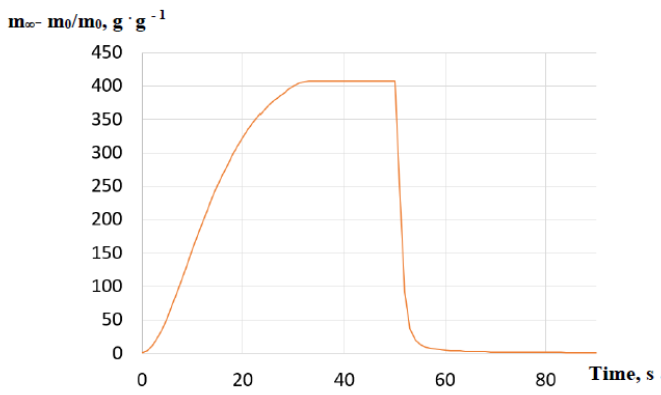
Figure 4. Change in mass of the sample over time due to swelling and release of water
The water content in the sample subsequently decreases sharply, returning the sample to its initial value. The characteristics of the drop are directly influenced by the diffusion coefficient D, reaction rate constants k, and the concentration of Crlinj radionuclides. The data are derived from field experiments.
Figure 5 illustrates the procedure for immobilizing radionuclides inside the designated area. Figure D.9 illustrates that the concentration of radionuclides remains at zero until maximum saturation is achieved; however, upon attaining the critical concentration of radionuclides in the mobile Crl form, the sample volume diminishes.
Consequently, the following outcomes were achieved: simulation of sample swelling due to diffuse migration; formulation of equations governing the swelling state of samples during diffuse migration; creation of a mathematical model for diffusion migration in a cylindrical coordinate system; and development of a numerical model for diffusion migration. A model was constructed to represent the alteration of the computation grid due to diffuse migration in the transformation of the sample shape.
A mathematical model was developed to describe the migration and fixation processes of radionuclides in both natural and artificial geochemical barriers at radioactive waste burial sites. The model utilizes the diffusion equation, which is addressed on a time-deformed grid. The numerical model is addressed using the explicit Eulerian scheme through the finite difference method. The numerical results indicate that the model effectively captures variations in mass and volume of samples over time.
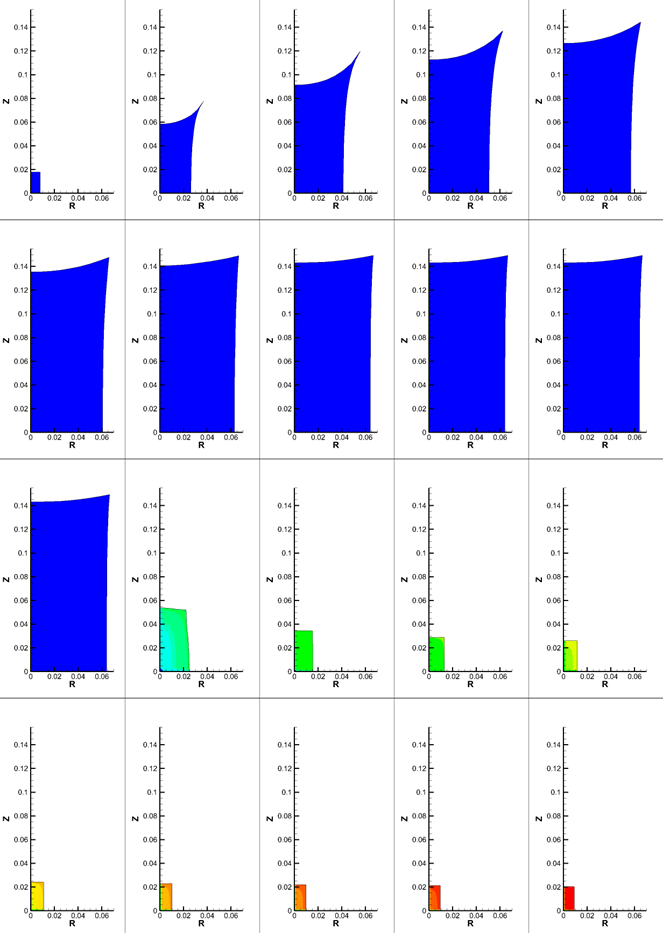
Figure 5. Deformation of the area and change in the concentration of radionuclides in the HCM over time as a result of swelling, release and fixation of radionuclides
Geochemical barriers can be made up of multi-layered hydrogel membranes that are made on a base of polymer nets (polyethylene, polypropylene, and polyvinyl chloride) so that they are easy to use in a range of conditions. They can be well placed in containers of different shapes (rectangular cassettes for use in storage tanks for HRC, cylindrical for creating "traps" for radionuclides in wells), which can be extracted from the radiation environment by special discharge devices in automated software mode (ASM) as the maximum permissible concentration of LRW is reached in storage tanks and underground groundwater (Fig. 6 and Fig. 7).
|
|
|
|
|
|
|
Reinforced HCM |
Swollen in water HCM |
|
HCM after radionuclide sorbtion |
|
Figure 6. Design of hybrid composite materials in the creation of geochemical barriers
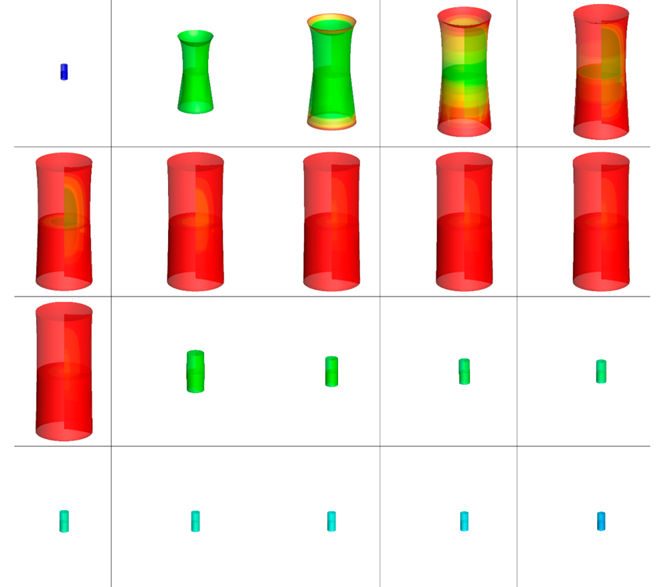
Figure 7 - Three-dimensional deformation of the area and change in the concentration of water in the sample over time as a result of swelling and release under radionuclide sorbtion
Thus, the hydrogel materials and their composites with intercalated mineral fillers for the development of a geochemical anti-migration barrier were discussed. Their practical applicability in addressing issues related to the prevention of LRW spreading in soil and groundwater has been estimated. This geochemical barrier will provide a reliable shield for pollutants over long periods of use, thus reducing the costs of cleaning up adjacent areas to industrial plants.
The studies yield the following conclusions:
- Synthesis and characterization of a novel class of hybrid composite materials consisting of intercalated complexes of natural minerals (bentonite, monthillonite, zeolite, and rutile) with ferrocyanide complexes of transition metals (FCTM) (phase 1) and a volume-embedded polymer matrix (phase II) have demonstrated significant sorption efficiency for liquid radioactive waste.
- The polymer matrix works well with different mineral fillers and their complexes that are intercalated with FCTM. This makes the hybrid composition more useful by working together better. This improves the efficiency of engineering structures during the design and construction of low- and medium-activity RN storage facilities.
- A comprehensive hydrodynamic-geochemical mathematical model was formulated for the fixation and concentration processes, elucidating the migration of radionuclides via natural and manmade geochemical barriers at low-level and intermediate-level radioactive waste disposal sites. The model relies on solving the diffusion equation for water molecules and hydrated radionuclide ions in a time-deformed grid, which allows for the calculation of penetration depth through the HCM layer, the direction of RN migration, and the prediction of the long-term performance of hybrid composite materials at liquid radioactive waste storage and disposal sites.
References:
- Handbook of Chemical Mass Transport in the Environment“, 2011, EdsЖ Louis J. Thibodeaux, D. Mackay. . –CRC Press, 2011. Toxicological and Environmental Chemistry 93(6). doi:10.1139/t96-021. DOI:10.1080/02772248.2011.5857777ю
- L.K. Sharmaa, Rajesh Singha,b, M. Ahmada , R.K. Umraoa , T.N. Singh. Experimental Evaluation of Geomechanical Behaviour of Bentonite-Sand Mixture for Nuclear Waste Disposal. Procedia Engineering 191:386-393 DOI:10.1016/j.proeng.2017.05.195
- Komine, H., Ogata, N. Experimental study on swelling characteristics of sand-bentonite mixture for nuclear waste disposal. Soils and Foundationd, 1999, 39 (2), 83 – 97. https://doi.org/10.3208/sandf.39.2_83
- Qiong Wang, Anh Minh A.M. Tang, Yu-Jun Cui, Pierre Delage, Behrouz Gatmiri. Experimental study on the swelling behaviour of bentonite/claystone mixture. Engineering Geology, 2012, 124, pp.59-66. 10.1016/j.engeo.2011.10.003.
- Shirokov, S.S., Kuznetsov, A.Y., Kholopova, O.V. et al. Decontamination of metal items with consideration of the secondary sorption of radionuclides. Radiochemistry 57, 178–181 (2015). https://doi.org/10.1134/S1066362215020101.
- Saleh, H.M.; Bayoumi, T.A. Retardation of inorganic barriers containing simulated radioactive borate waste during immersion process. Int. J. Chemical Sci&Technology, 2014, 293-301.
- Samir, B., Eskander., Hosam, M., Saleh. (2012). Cement mortar-degraded spinney waste composite as a matrix for immobilizing some low and intermediate level radioactive wastes: Consistency under frost attack. Journal of Nuclear Materials,2012, 420(1):491-496. doi: 10.1016/J.JNUCMAT.2011.10.041.
- Jedla, M.R.; Koneru, B, Franco Jr, A.; Rangappa, D.; Banerjee, P. Recent Developments in Nanomaterials Based Adsorbents for Water Purification Techniques, 2022, 12 (5): 5821 – 5835. doi.org/10.33263/BRIAC125.58215835. (materials)
- Peppas N. A. and Sahlin J. J. A Simple Equation for the Description of Solute Release III. Coupling of Diffusion and Relaxation // International Journal of Pharmaceutics. – 1989. – Vol. 57, No. 2. – Р.169-172. doi:10.1016/0378-5173(89)90306-2.
- Rossi G. and Mazich K. A. Macroscopic Description of the Kinetics of Swelling for a Cross-Linked Elastomer or a Gel // Physical Review E. –1993. – Vol. 48, No. 2. – Р. 1182-1191. doi:10.1103/PhysRevE.48.1182.
- Mazich K. A., Rossi G. and Smith C. A. Kinetics of So- lvent Diffusion and Swelling in a Model Elastomeric System // Macromolecules – 1992. – Vol. 25, No. 25. – Р. 6929-6933. doi:10.1021/ma00051a032.
- Mamytbekov G.K., Zheltov D.A. and Nurtazin Y.R. Synthesis and Investigation of the Properties of Biphasic Hybrid Composites Based on Bentonite, Copper Hexacyanoferrate, Acrylamide and Acrylic Acid Hydrogel// Polymers. – 2023. – Vol.15. – P.2586. https://doi.org/10.3390/polym15122586.

